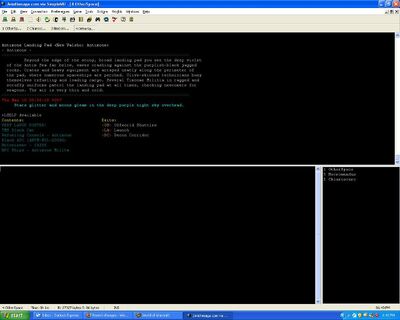
|
|
|
|
|
Roleplaying: RP Articles | Logs | Characters | Stories | Art Promotional: MU* Promotional Pages | Recruiting Graffiti Board | MU* Reviews Code: Useful Code Snippets |
|
What Is This? MU*Wiki is devoted solely to MU*s. We're all about the promotion and discussion of prose-based online multiplayer role-playing games that pre-date the big graphical MMOs. These games are still plugging along, trying to do for (mostly) free with words what the big-budget MMOs do for a monthly fee. This Wiki allows for individual games to have their own pages, players to post moderated reviews of those games, game-inspired fiction, sharing of code snippets, and articles about MU* creators. <createbox> bgcolor=#f3f3ff </createbox> |
|
Bleached InuYasha Galaxy MU* Website: http://www.biyg.org MU* Telnet Address: biyg.org 1801 Bleached InuYasha Galaxy (previously known as InuYasha Galaxy) is a hybrid MUD that mixes together the Bleach and InuYasha anime series into one unique intense adventure. Our average player count ranges from 5-20 players online. One of our most unique features is our shard system, where shards (shikon shards) of a jewel (the Shikon no Tama) have been scattered across both eras, thus players can find these shards and use them to increase their own power by embedding them into body parts as well as attaching them to items. This plays a very important role in our intense PK system as well. There is virtually no limit for the strength of a player, and we have absolutely no stock areas, classes, or races. Since players have full control over the clan system, clan wars become extremely bloody (and even more so with shikon shards in play). (more) |
 The Rangers Emblem
|
|
|
|
Plot Basics: Developing a Storyline
Now, you may have an excellent original theme or perhaps you've built a game based on a popular established theme, and thus you think that all you must do now is open the doors, throw up a website, and watch the hordes come in. Sorry, no. You're going to need a story to keep them engaged. And that story can't just end cleanly someday - it should be perpetual, encouraging your players to keep coming back to find out what's going to happen next. And you're going to need to make sure the players feel like they have an impact on the story as it evolves, and that they are more than just rats in a maze. And you're going to have to roll with the twists and turns they throw at you just as much as you expect them to roll with your own. Many of you are probably familiar with the concept of a TinyPlot, or TP. These are often short-term events and often self-contained. A story arc is nothing more, in the simplest context, than a series of related TinyPlots woven together to form a cohesive storyline - a roleplaying tapestry. You provide the pattern for the tapestry, but the actions of the players shape and color it. Each story arc should consist of a series of major arc-related activities, interspersed with tangential activities - don't train players to just come around when you have specific arc activities; encourage them to be around as often as possible. One good way of thinking of a story arc is as a bridge, taking you over a river to your destination. The major events are the support pylons. The tangential events are guidewires and other structures that keep the bridge standing, keep the traffic moving, and keep everyone going toward that destination. Or, another way: Think of story arcs as a house, with major events as bricks, and tangential events as mortar holding those bricks together. And once you've crossed that bridge, or built that house, you need to keep pointing toward the horizon, toward what comes next. Keep them guessing. Keep them interested. Now let's backtrack a little and talk about designing a single storyline. Many players are resistant to "scripted" activities. Don't mistake the concept of a story arc as a script. It's not. It's an outline. It's a blueprint. |
Policy Coming soon! |